Abstract
Background:
Dermatophytoses refer to superficial fungal infection of keratinized tissues caused by keratinophilic dermatophytes. According to observations worldwide, dermatophytoses are the most common of the superficial fungal infections. It is common in tropics and may present in epidemic proportions in areas with high rates of humidity. Although common, the precise size of the problem defies measurement.
Aims:
The present study was undertaken to assess the clinical profile of dermatophytic infection and to identify the species of fungi that are prevalent in this region.
Materials and Methods:
A total of 100 patients clinically suspected for dermatophytoses were selected for the study. Direct microscopy in 10% potassium hydroxide (KOH) and culture was done in each case.
Results:
Out of 100 patients, the maximum were seen in the age groups of 16-30 years. Tinea corporis was the most common clinical type (44.3%) followed by tinea cruris (38.2%). Overall positivity by culture was 39% and by direct microscopy 96%.
Conclusion:
Trichophyton rubrum was the predominant species isolated (67.5%) in all clinical types followed by Trichophyton mentagrophytes. Culturing the fungus may identify the species, but it is not essential for the diagnosis as it is not a sensitive test.
Keywords: Dermatophytosis, dermatophyte, tinea, trichophyton
Introduction
What was known?
Dermatophytosis is a common superficial fungal infection. Tinea corporis and tinea cruris are the common types. Trichophyton rubrum is the predominant isolate in most clinical types.
Dermatophytes are aerobic fungi that produce proteases that digest keratin and allows colonization, invasion and infection of the stratum corneum of the skin, the hair shaft, and the nail.[1] Infection is generally cutaneous and restricted to the nonliving cornified layers because the fungi is not able to penetrate the deeper tissue or organ of healthy immunocompetent host. The infection is commonly designated as ring worm or “tinea”. Tinea literally refers to insect larva (cloth moth) that was felt by Romans to be the cause of infection. Dermatophytes are moulds belonging to the three genera of fungi imperfecti (1) Microsporum, (2) Trichophyton, and (3) Epidermophyton.[2]
The present study was undertaken to assess the clinicoepidemiological profile of dermatophytic infection to identify the species of fungi and to compare the clinical diagnosis with potassium hydroxide (KOH) smear positivity and culture positivity.
Materials and Methods
The study population included 100 patients clinically suspected as having dermatophytosis randomly selected from the Dermatology outpatient department of Father Muller Medical College hospital Mangalore from August 2005 to July 2006.
A detailed clinical history including age, sex, socioeconomic status, occupation, duration of disease, history of recurrence and type of lesion, similar complaints in the family and contacts with animals or soil were elicited and recorded in all cases. General physical examination and systemic examination was conducted and investigations like hemoglobin, total count, differential count, blood sugar, and liver function test were done whenever necessary.
Both the sexes aged between 1 and 60 years were included in this study. Infants, age groups above 60 years, immunocompromised patients, secondarily infected, and those who have taken other modality of treatment like steroid excluded in this study. The patients were classified according to the site of involvement. The specimen was collected by scraping the active edge of the affected skin, nail scraping, clipping and epilation of the infected and lusterless hair. Material was subjected to direct microscopic examination using 10% KOH. For primary isolation Sabouraud's dextrose agar slopes were used and dermatophyte test media was used as a selective media. Slide culture was done to study the micromorphology of microconidia and macroconidia, nature of the sporulation, special structures such as spirals, pectinate, racquet hyphae, and chlamydospores. Special tests were performed when necessary, viz, hair perforation test and biochemical test like urease test was done for species identification.
Statistical analysis was done by using Chi-square test.
Results
A total of 100 patients were enrolled in the study, comprising of 62 males and 38 females. Maximum number of cases were in the age groups of 16-30 years (44 cases). The youngest patient was a 6-year-old boy and the eldest was a 60-year-old man. Our study revealed that dermatophytosis was more common in males (62%) than in females (38%). Out of 100 patients, 46 patients had multiple site involvement hence the total number of clinical pattern was 149, which was higher than the total number of patients. Tinea corporis (44.3%) was the most common clinical pattern observed followed by tinea cruris (38.2%), tinea pedis (2.7%), tinea manuum (3.3%), tinea unguium (8.1%), tinea barbae (2.1%), and tinea faciei (1.3%) [Table 1]. No cases of tinea capitis was seen in either sex. Tinea corporis (44%) was the most common clinical pattern seen in females followed by tinea cruris (32%). Tinea cruris (68%) was the most common clinical type seen in males followed by tinea corporis (56%). Majority of the tinea unguium (six cases) was noticed in the age group of 31-45 years. Dermatophytosis was more common in males below 30 years and in females more cases were seen above 30 years. Various types of coexisting forms of dermatophytic infections were also encountered as shown in Table 2.
Table 1.
Depicting comprehensive information in relation to sex, age group, clinical types and percentage of clinical pattern

Table 2.
Combination of various clinical types of dermatophytoses with percentage
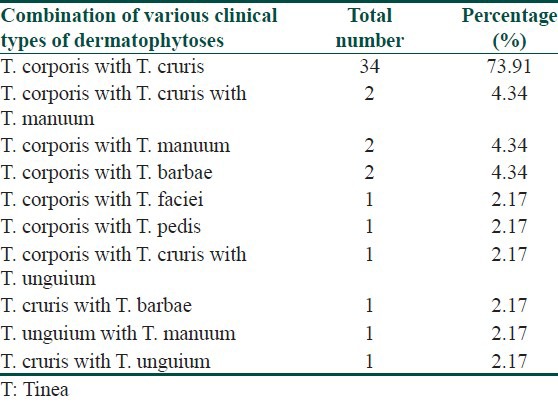
Out of 100 cases, 96 cases were positive on direct KOH mount and 39 were culture positive. In 35 cases, both KOH and culture were positive and remaining 4 cases, which were negative on direct microscopy, showed culture positivity. In the present study, all the three genera of dermatophytes, that is, Trichophyton, Epidermophyton, and Microsporum were isolated as causative agents of infection. Out of the total number of six different species isolated Trichophyton rubrum (67.5%) [Figures 1 and 2] was the highest followed by Trichophyton mentagrophytes (20%) [Figure 3], Epidermophyton floccosum (5%) [Figure 4], Trichophyton schoenleinii (2.5%) [Figures 5 and 6], Microsporum canis (2.5%) [Figures 7–9], and Microsporum audouinii (2.5%) [Figures 10–12]. One case showed combined infection by T. rubrum and T. mentagrophytes, which brings up the total number of isolates to 40 [Table 3].
Figure 1.
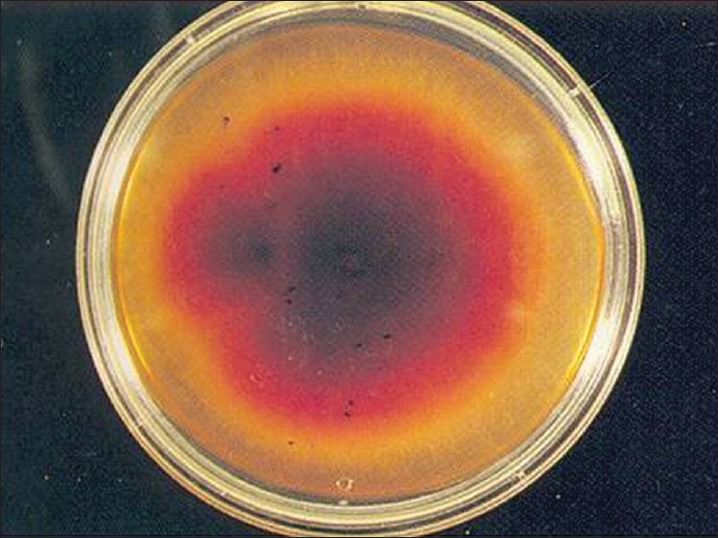
Reverse view of macroscopic colony morphology of Trichophyton rubrum showing port-wine pigmentation
Figure 2.
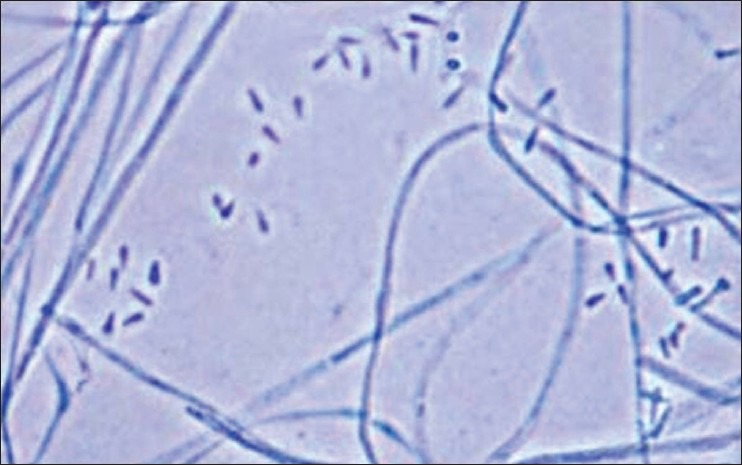
Micromorphology of Trichophyton rubrum showing microconidia present singly along the hyphae
Figure 3.
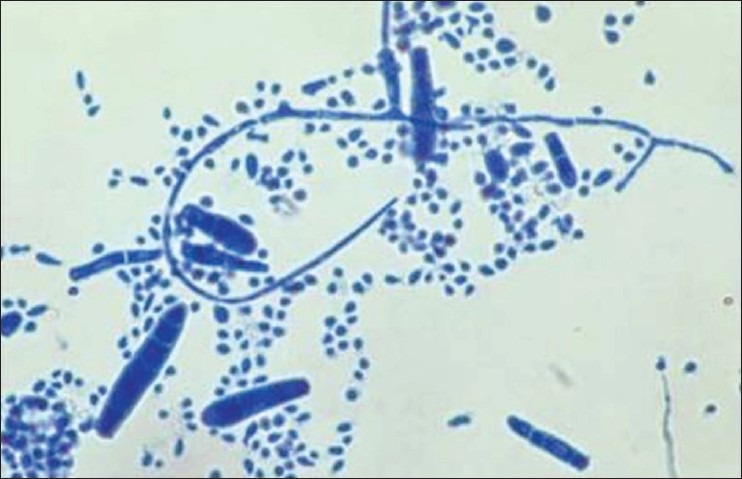
Micromorphology of Trichophyton mentagrophyte showing microconidia, spherical, and pyriform shaped, arranged in clusters along the hyphae
Figure 4.
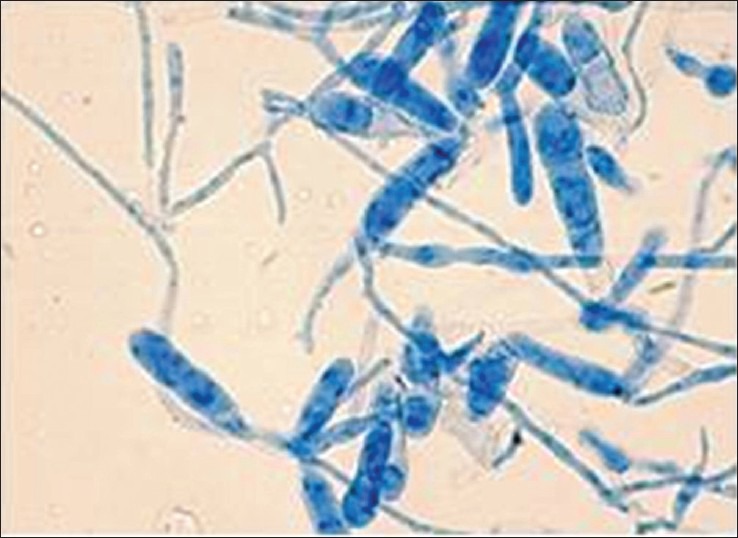
Micromorphology of Epidermophyton floccosum showing terminal blunt club-shaped macroconidia attached together
Figure 5.
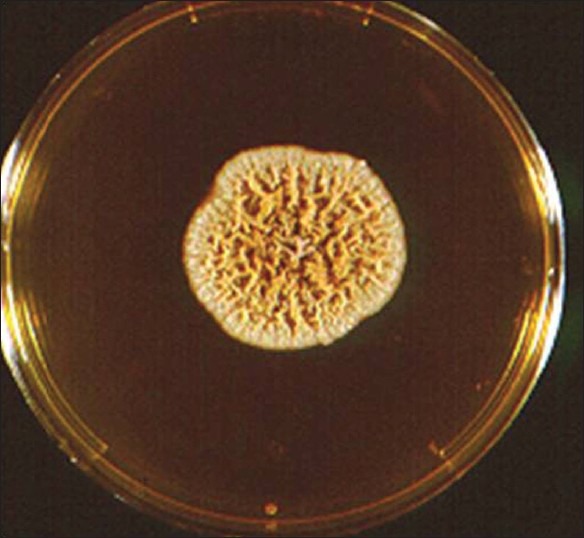
Macroscopic morphology of Trichophyton schoenlienii showing cream colored colony having a cerebriform or honey comb appearance
Figure 6.
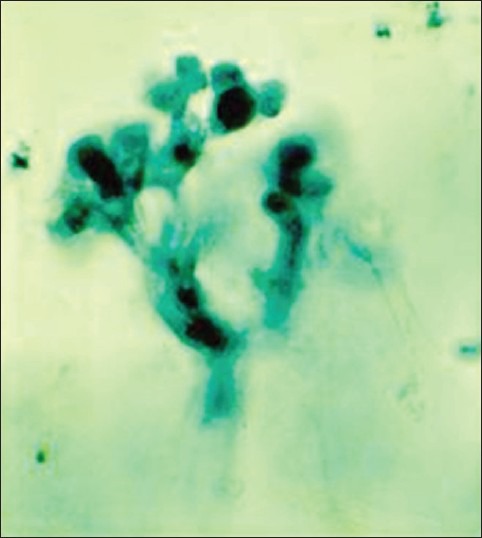
Micromorphology of Trichophyton schoenlienii showing antler like terminals with terminal branching swollen hyphal tips
Figure 7.
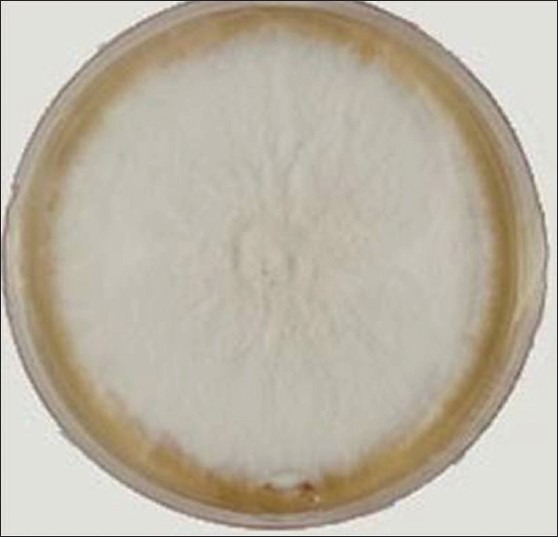
Obverse view of macroscopic colony morphology of Microsporum canis showing white velvety with central depression
Figure 9.
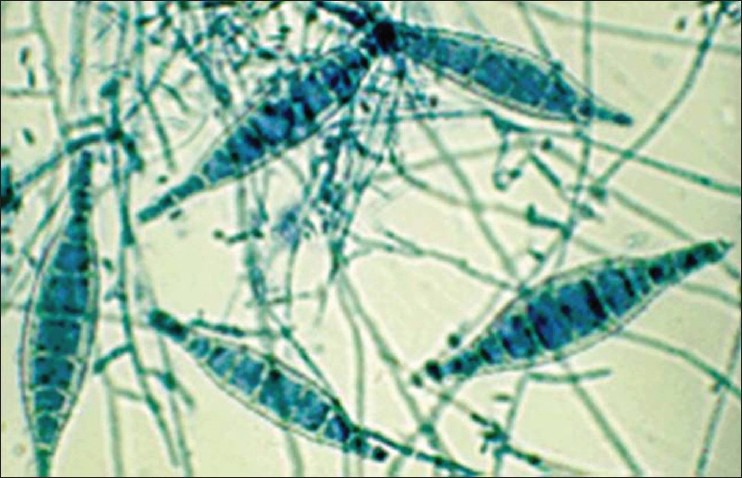
Micromorphology of Microsporum canis showing predominantly pluriseptate macroconidia
Figure 10.
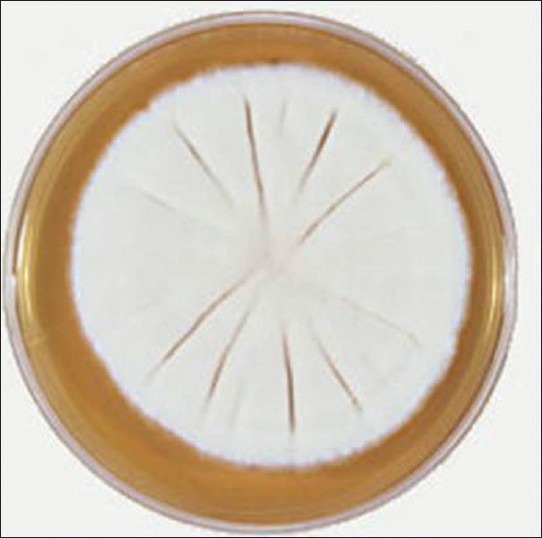
Obverse view of macroscopic colony morphology of Microsporum audouinii showing grayish-white surface with mouse fur texture
Figure 12.
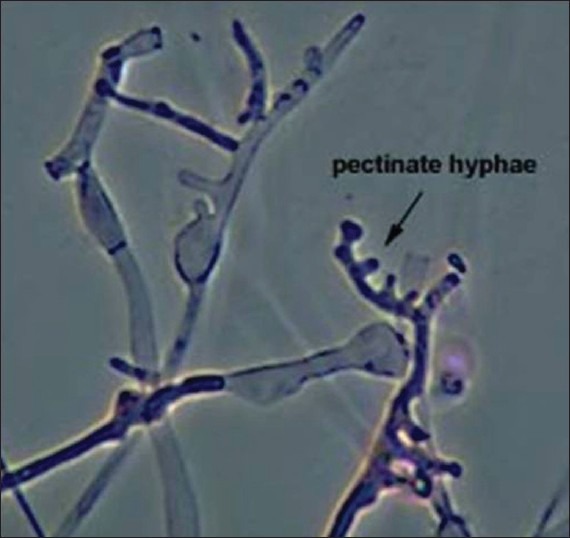
Micromorphology of Microsporum audouinii showing few microconidia with chlamydospores and pectinate hyphae
Table 3.
Clinical types, species isolated and KOH positivity (clinicomycological correlation)

Figure 8.
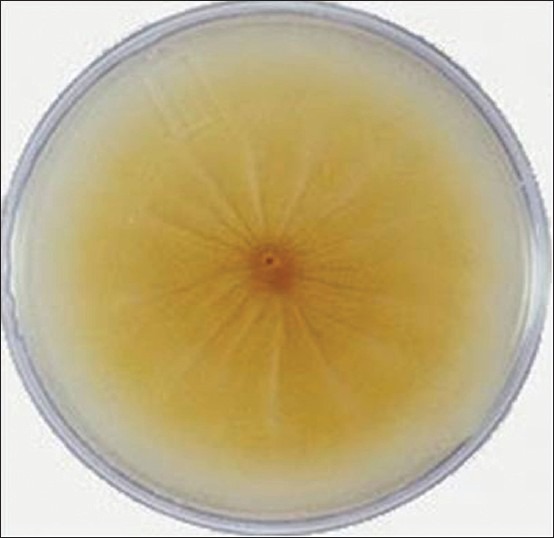
Reverse view of macroscopic colony morphology of Microsporum canis showing yellowish pigment
Figure 11.
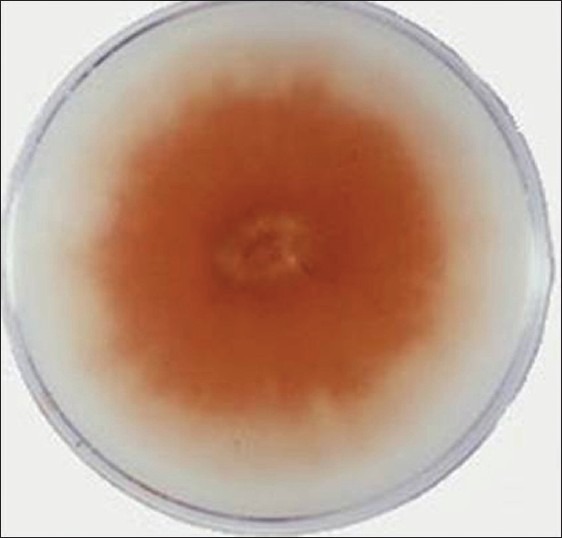
Reverse view of macroscopic colony morphology of Microsporum audouinii showing peach colored pigment
Discussion
The present study was conducted in Mangalore situated in western coast of south India having hot and humid climate which is more favorable for the development of superficial mycoses. In the present study of 100 cases of dermatophytic infections, the following clinical forms were observed: tinea corporis, tinea cruris, tinea pedis, tinea manuum, tinea unguium, tinea barbae, and tinea faciei. As regards to the age incidence, maximum number of cases encountered was in the age group of 16-30 years (44%). This is in accordance with the findings of other workers.[3,4,5] This is followed by the age group of 31-45 years (26%). Although the majority of studies have observed higher incidence in the third decade, the study done at Calicut by Bindu. observed higher incidence in the second decade.[3] Dermatophytosis was more common in males below 30 years and in females more cases were seen above 30 years. Similar findings were noticed in a study by Sentamilselvi.[6] The higher incidence in males could be due to greater physical activity and increased sweating. Among the clinical types, tinea corporis was revealed to be highest (66 cases) followed by 57 cases of tinea cruris. This is in accordance with the Bindu et al. study and other studies, which have also stated that tinea corporis and tinea cruris are the most common clinical type of dermatophytic infections.[5,6,7] In the studies by Sardari et al.[8] and Verma et al.,[9] it has been reported that tinea cruris was the most common clinical type. However, in our study tinea corporis was common in comparison with tinea cruris. In another clinicomycological study of superficial mycosis in a hospital in north-east India,[10] it was observed that tinea pedis (29.2%) as the most common dermatophytosis followed by tinea cruris (26.2%), which differs from other studies. Among 46 mixed clinical types, tinea corporis with tinea cruris was highest (34 cases, 73.91%). Similar findings have been reported by Peerapur et al.[4] No case of tinea capitis was noticed in this study, thereby confirming its low incidence, which is in accordance with the findings of other studies, for example, Mehta.[11] This is different from the study done at urban clinic Kolkata where tinea capitis was the most common dermatophytic infection in children.[12] In the present study, it was possible to demonstrate fungi on direct microscopy with KOH in 96 cases but overall positivity by culture was 39% as noticed in other studies.[3,13] However, a study by Belukar et al.[7] showed culture positivity of 71%, which was much higher and a study done at Aurangabad showed low rate of culture positivity of 22.8%.[13]
In all clinical patterns, T. rubrum was the chief organism isolated with a percentage of 67.5%. This is in accordance to reports of other workers from different regions of India.[2,3,5,10] T. mentagrophytes (20%) isolates were found second in frequency similar to the study from Calicut, which are relatively more prevalent in south India.[3] E. floccosum was the most common etiological agent of dermatophytosis in a study by Pashkir at Karaj city, Tehran.[14] However, in another study by Grover et al. in north-east India isolated T. tonsurans as the most common dermatophyte followed by T. rubrum, which differs from other studies that reports T. rubrum as the most common fungal pathogen.[12] Overall, the Trichophyton genera dominated with 90% of the isolates followed by Epidermophyton (5%) and Microsporum (5%), in majority of the studies undertaken.[3,5,10] Correlating clinical and mycological data, as shown in Table 3, it is found that in all clinical patterns, T. rubrum was the chief organism isolated (55.5%) followed by T. mentagrophytes (33.3%) from the infections of glaborous skin, which is in agreement with majority of other studies reported from India and other countries.[2,3,5,13]
Conclusion
Present clinicomycological study showed tinea corporis as the most common clinical pattern followed by tinea cruris and T. rubrum as the most common causative agent of dermatophytosis in this region of Karnataka. Tinea capitis was not encountered in our study probably because of higher living standard and good personal hygiene. Culturing the fungus may identify the species, but it is not essential for the diagnosis as it is not a sensitive test.
What is new?
Though isolating species by culture methods is specific, it is not sensitive and may not determine the outcome of management. Environmental factors like humidity, hygiene, and socioeconomic factors influence the clinical type of dermatophytic infection.
Footnotes
Source of Support: Nil
Conflict of Interest: Nil.
References
- 1.Gorbach SL, Bartlett JL, Blacklow NR. 3rd ed. Philadelphia: Lippincott Williams and Wilkins; 2004. Infectious disease; pp. 1162–80. [Google Scholar]
- 2.Kanwar AJ, Mamta, Chander J. Superficial fungal infections. In: Valia GR, editor. IADVL Text book and Atlas of Dermatology. 2nd ed. Mumbai: Bhalani Publishing House; 2001. pp. 215–58. [Google Scholar]
- 3.Bindu V, Pavithran K. Clinico-Mycological study of dermatophytosis in Calicut. Indian J Dermatol Venereol Leprol. 2002;68:259–61. [PubMed] [Google Scholar]
- 4.Peerapur BV, Inamdar AC, Pushpa PV, Srikant B. Clinico Mycological Study of Dermatophytosis in Bijapur. Indian J Dermatol Venerol Leprol. 2004;22:273–74. [PubMed] [Google Scholar]
- 5.Singh S, Beena PM. Profile of Dermatophyte infection in Baroda. Indian J Dermatol Venerol Leprol. 2003;69:281–3. [PubMed] [Google Scholar]
- 6.Sentamilselvi G, Kamalam A, Ajithadas K, Janaki C, Thambiah AS. Scenario of chronic dermatophytosis: An Indian study. Mycopathologia. 1997;140:129–35. doi: 10.1023/a:1006843418759. [DOI] [PubMed] [Google Scholar]
- 7.Belukar DD, Barmi RN, Karthikeyan S, Vadhavkar RS. A Mycological study dermatophytosis in Thane. Bombay Hosp J. 2004;46:2. [Google Scholar]
- 8.Sardari L, Sambhashiva RR, dandapani R. clinico mycological study of dermatophytes in a coastal area. Indian J Dermatol Venereol Leprol. 1983;49:2:71–5. [PubMed] [Google Scholar]
- 9.Verma BS, Vaishnav VP, Bhat RP. A study of dermatophytosis. Indian J dermatol Venerol Leprol. 1970;36:182. [PubMed] [Google Scholar]
- 10.Grover SC, Roy PC. Clinicomycological profile of superficial mycosis in a hospital in North East India. Medical Journal Armed Forces India. 2003;59:114–16. doi: 10.1016/S0377-1237(03)80053-9. [DOI] [PMC free article] [PubMed] [Google Scholar]
- 11.Mehta JP, Deodhar KP. A study of dermatophytes in Bombay. Indian J Pathol Microbiol. 1977;20:23–31. [PubMed] [Google Scholar]
- 12.Barbhuiya JN, Das SK, Ghosh A, Dey SK, Lahiri A. Clinico mycological study of superficial fungal infection in children in an Urban clinic in Kolkata. Indian J Dermatol. 2002;47:221–3. [Google Scholar]
- 13.Patwardhan N, Dave R. Dermatophytosis in and around Aurangabad. Indian J Pathol Microbiol. 1999;42:455–62. [PubMed] [Google Scholar]
- 14.Pakshir K, Hashemi J. Dermatophytosis in Karaj, Iran. Indian J Dermatol. 2006;51:262–4. [Google Scholar]


